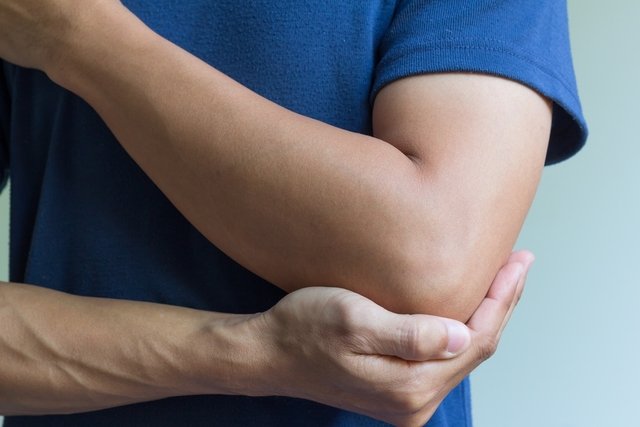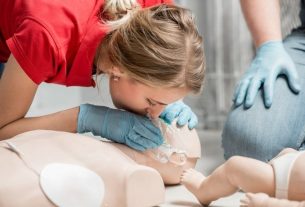Some measures can be taken when a person has a dislocation in a joint, until they receive medical attention, such as placing cold compresses on the area, elevating the affected limb, when possible, and not forcing the joint to avoid damage to tissues, blood vessels or nerves. around the joint.
Dislocation happens when the bones that form a joint are displaced from their natural position, due to trauma such as a strong blow or falls, for example, and can happen in any joint, being more common in the fingers, ankles, elbows, shoulders, hips or feet. See other causes of dislocation.
Dislocation is considered a medical emergency and, therefore, it is important to seek medical attention as quickly as possible, so that the diagnosis can be made and the most appropriate treatment can be initiated, in order to avoid complications of the dislocation, such as bleeding in the joint or problems with healing, for example.

How to identify a dislocation
Dislocation can be confirmed when these 4 signs exist:
- Very severe pain in the joint;
- Difficulty moving the affected limb;
- Swelling or purple spots in the joint;
- Deformation of the affected limb.
Depending on the type of blow and its intensity, the dislocation can also occur with a fracture of the bone. In this case, you should also avoid correcting the fracture, and it is advisable to go to the emergency room quickly. Learn how to identify a dislocation.
What to do
If a dislocation occurs, you should go to the emergency room, the nearest hospital or call the emergency medical care service (SAMU), at number 192.
However, until medical care occurs, it is important to take some precautions, such as:
1. Do not force the affected limb
When a dislocation occurs in any joint of the body, such as a finger, hand, elbow, shoulder, knee, hip, foot or ankle, for example, one should not force the affected limb or try to move it, as this can cause complications such as tearing. blood vessels or damage to nerves near the joint.
2. Immobilize the affected limb
To prevent the joint from moving and causing complications, it is important to immobilize the affected limb, using a sling, using fabric, a band or a belt, or using a splint or cushion, for example.
3. Elevate the member
When the dislocation occurs in the elbow or hands, the affected limb must be elevated above the height of the heart, which can be done by keeping the hand up or resting it on a cushion or pillow, for example. By elevating the affected limb, the swelling that may arise is reduced.
However, if you suspect an injury to the legs, hips, pelvis, back or hips, you should not elevate the legs or attempt to move the person until help arrives at the scene.
4. Apply cold compresses
It is important to apply the cold compress immediately as soon as the dislocation occurs, to help reduce inflammation, pain and swelling in the affected area.
To make a cold compress, you must place ice inside a thermal bag or plastic bag, and then wrap the bag or bag in a clean, dry towel and apply it to the affected area.
5. Not trying to put the joint in place
When a dislocation occurs in any joint, it is essential not to try to put the joint in place on your own, as it can cause serious complications, such as damage to the nerves, blood vessels, or infection in the affected joint.
In addition, damage to the joint cartilage may also occur. Therefore, joint repositioning should only be done by a doctor in the hospital.
6. Wash the affected limb
Washing the affected limb is recommended when there is an injury or break in the skin at the site of the dislocation, in order to remove dirt that could increase the risk of infection.
To wash the affected area, you must wash it under running water, without rubbing the skin in the affected area. It is then recommended to cover with sterile gauze before immobilizing the affected limb.
7. Do not move the person with dislocation
In the case of a dislocation in the hip, pelvis or upper part of the leg, or when there is a risk of injury or wounds to the back, legs or neck, it is important not to move the person until the ambulance arrives, in order to avoid complications.
In this case, you should calm the person and try to keep them comfortable.
How the treatment is carried out
Treatment is indicated by the doctor according to the type of dislocation, however in most cases the use of analgesics is recommended to alleviate symptoms. In addition, the doctor places the joint in place with the aim of speeding up the person’s recovery process. See how the main types of dislocation are treated in the hospital.
How to avoid a dislocation
The best way to avoid a dislocation is to use recommended safety equipment for dangerous activities. For example, in the case of high-impact sports, it is advisable to always use knee and elbow protectors or protective gloves.
In the case of children, you should also avoid pulling on their arms, hands, legs or feet, as this can cause excessive force on the joint, which ends up causing a dislocation.

Sign up for our newsletter and stay up to date with exclusive news
that can transform your routine!
Warning: Undefined array key "title" in /home/storelat/public_html/wp-content/plugins/link-whisper-premium/templates/frontend/related-posts.php on line 12
Warning: Undefined array key "title_tag" in /home/storelat/public_html/wp-content/plugins/link-whisper-premium/templates/frontend/related-posts.php on line 13




